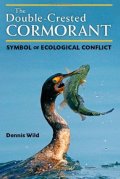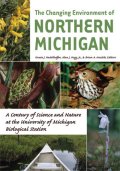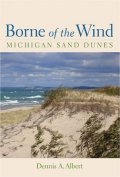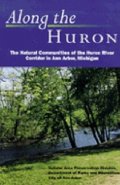On this page
University of Michigan PressThis page lists books published by University of Michigan Press that are wholly or partly about birds. The books are arranged by publication date with the most recent at the top.
|
|
|
|
The Kirtland's Warbler: The Story of a Bird's Fight Against Extinction and the People Who Saved ItWilliam Rappai
University of Michigan Press
2013
"In The Kirtland's Warbler, William Rapai explores the bird's fascinating natural history as well as the complex and evolving relationships between the warbler, its environment, its human protectors, and state and federal policies that today threaten to eradicate decades of work done on the species' behalf. Beginning with an account of the warbler's discovery in the mid-nineteenth century and ornithologists' desperate hunt for information on the elusive new species, the book goes on to examine the dramatic events that quickly led to the warbler's precarious status and its eventual emergence as a lightning rod for controversy. The Kirtland's warbler is often described as a "bird of fire" for its preference for nesting in areas cleared by wildfire. But it also warrants the name for the passion it ignites in humans. Both tragic and uplifting, the story of this intriguing bird is a stirring example of how strong leadership, vision, commitment, sustained effort, and cooperation can come together to protect our natural world."
|
Buy from amazon.co.uk 
|
|
The Double-Crested Cormorant: Symbol of Ecological ConflictDennis Wild
The University of Michigan Press
2012
"In The Double-Crested Cormorant: Symbol of Ecological Conflict, Dennis Wild brings together the biological, social, legal, and international aspects of the cormorant's world to give a complete and balanced view of one of the Great Lakes' and perhaps North America's most misunderstood species. In addition to taking a detailed look at the complex natural history of the cormorant, The Double-Crested Cormorant: Symbol of Ecological Conflict explores the implications of congressional acts and international treaties, the workings and philosophies of state and federal wildlife agencies, the unrelenting efforts of aquaculture and fishing interests to "cull" cormorant numbers to "acceptable" levels, and the reactions and visions of conservation groups. Wild examines both popular preconceptions about cormorants (what kinds of fish they eat and how much) and the effectiveness of ongoing efforts to control the cormorant population. Finally, The Double-Crested Cormorant: Symbol of Ecological Conflict delves into the question of climate and terrain changes, their consequences for cormorants, the new territories to which the birds must adapt, and the conflicts this species is likely to face going forward."
|
Buy from amazon.co.uk 
|
|
The Changing Environment of Northern Michigan: A Century of Science and Nature at the University of Michigan Biological StationEditor: Knute J. Nadelhoffer, Alan J. Hogg, Jr., and Brian A. Hazlett
University of Michigan Press
2009
"Northern Michigan is undergoing unprecedented changes in land use, climate, resource extraction, and species distributions. For the last hundred years, the University of Michigan Biological Station has monitored these environmental transformations. Stretching 10,000 acres along Burt and Douglas Lakes in the northern Lower Peninsula and 3,200 acres on Sugar Island near Sault Ste. Marie, Michigan, the station has played host to nearly 10,000 students and a steady stream of top scientists in the fields of biology, ecology, geology, archeology, and climatology. The Changing Environment of Northern Michigan collects essays by some of these scientists, who lead readers on virtual field trips exploring the history of people and science at the station itself, the relations of indigenous people to the land, the geophysical history of the region, characteristics of terrestrial and aquatic ecosystems, key groups of organisms and their relations to local habitats, and perspectives on critical environmental challenges of today and their effects on the region. Accompanying the chapters are color illustrations and photographs that bring the station's pristine setting to life."
|
Buy from amazon.co.uk 
|
|
Michigan: Our Land, Our Water, Our HeritageEditor: John Knott
University of Michigan Press
2008
"Michigan was once covered with vast, unbroken forests of pine and hemlock mixed with birch and poplar, and oak savannas marched as far as the eye could see. But in the process of settling the state and exploiting its natural resources, we have drained wetlands, dammed rivers, and cut all but a few remnants of the virgin forests, leaving that untouched Michigan hard to imagine now. Yet important steps are being taken to protect Michigan's natural beauty, and the fact that we are able to enjoy our state today depends on the work of The Nature Conservancy and the various land conservancies and agencies with which it collaborates. The engaging essays in this book illustrate the range of ecosystems that The Nature Conservancy has protected. Included are essays by nine acclaimed Michigan authors; numerous quotes from leading figures in Michigan; and full-color photographs by well-known Michigan photographers of the land, water, and shorelines of the Great Lakes state. Proceeds from this publication support conservation in Michigan and the Great Lakes."
|
Buy from amazon.co.uk 
|
|
Borne of the Wind: Michigan Sand DunesDennis A. Albert
University of Michigan Press
2006
"Sand dunes are among the most rugged and beautiful natural features of the Lake Michigan and Lake Superior shorelines. These dunes comprise the most extensive freshwater dunes in the world, so vast that they are visible to astronauts from outer space. The coastal dunes are also incredibly rich, supporting a vast variety of plants and animals. Borne of the Wind describes the environmental factors necessary for dune creation in an easy-to-understand format. Each of the distinct types of dunes encountered along the Great Lakes shoreline is explained and illustrated with color photographs and line drawings. Color photographs of the plants and animals found in duneland areas complement the story of the ever-changing landscapes."
|
Buy from amazon.co.uk 
|
|
Great Lakes Nature: An Outdoor YearMary Blocksman
Illustrations: Robin Wilt
University of Michigan Press
2004
"From blue moons to bald eagles, this new edition of Great Lakes Nature -now lavishly illustrated in color - is a guide to nature's everyday but often-overlooked gems. With an open-mind and the curiosity of an old-fashioned naturalist, author Mary Blocksma furnishes more than just ecological nomenclature; she unearths a treasure trove of tips, hints, and trivia. Blocksma set out to identify her Great Lakes environment just a name at a time, a few times a week, for a year. Coming upon a bird, tree, or natural phenomenon she doesn't recognize, the author takes us along on her process of learning. The result is a book that educates through the delight of serendipitous discovery as it transports the armchair explorer out of the living room and into the forests and wetlands of the Great Lakes region."
|
Buy from amazon.co.uk 
|
|
Along the Huron: The Natural Communities of the Huron River Corridor in Ann Arbor, MichiganNatural Area Preservation Division, Department of Parks and Recreation, City of Ann Arbor
University of Michigan Press
1999
"The natural areas along the Huron River Corridor in Ann Arbor offer the interested explorer an opportunity to see some of nature's finest works. Among the thirteen natural communities presented, one can see different ecosystems of marshes, meadows, prairies, old fields, shrublands, and various types of forests. Each of the ecosystems offers common, rare, and extremely rare plants to discover and fascinating animals to see. This readable and easily accessible guide to thirteen gems along the river presents comprehensive trail information and accurate descriptions of the 630 acres of undeveloped green space in Ann Arbor. Each ecosystem is explained in understandable language. Maps of each natural area offer precise and detailed information of what you will see and where you will find what you are looking for. Tables and charts provide concise and informative comparisons of the parks. Useful illustrations and accurate descriptions of the plants, animals, and locations help the explorer get the most pleasure from a visit to every natural community presented in the book."
|
Buy from amazon.co.uk 
|
|
The Birds of Washtenaw County, MichiganMichael A. Kielb, John M. Swales, and Richard A. Wolinski
University of Michigan Press
1993
"The Birds of Washtenaw County, Michigan provides a comprehensive account of the birdlife in Washtenaw County. Situated to the west of Detroit in southeast Michigan, the county has an exceptionally rich history of ornithological study, fueled by the activities of numerous amateur birdwatchers and by the interests of two major universities. Frequency accounts of the 267 species recorded in the county during the last 15 years are framed by a discussion of the topographical history of the county. In addition, the authors present notes on another 30 species not seen in the county since 1976. A comprehensive site guide offers suggestions of the optimal locals and times to try to find the birds."
|
Buy from amazon.co.uk 
|
|
A Guide to Michigan's Endangered WildlifeDavid C. Evers
University of Michigan Press
1992
"A descriptive profile of Michigan's threatened and endangered wildlife."
|
Buy from amazon.co.uk 
|
|